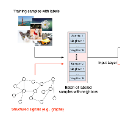Sign languages serve as essential communication systems for individuals with hearing and speech impairments. However, digital linguistic dataset resources for underrepresented sign languages, such as Nepali Sign Language (NSL), remain scarce. This study introduces the first benchmark dataset for NSL, consisting of 36 gesture classes with 1,500 samples per class, designed to capture the structural and visual features of the language. To evaluate recognition performance, we fine-tuned MobileNetV2 and ResNet50 architectures on the dataset, achieving classification accuracies of 90.45% and 88.78%, respectively. These findings demonstrate the effectiveness of convolutional neural networks in sign recognition tasks, particularly within low-resource settings. To the best of our knowledge, this work represents the first systematic effort to construct a benchmark dataset and assess deep learning approaches for NSL recognition, highlighting the potential of transfer learning and fine-tuning for advancing research in underexplored sign languages.
翻译:暂无翻译




